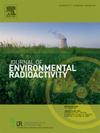Long-range transport model analysis on seasonal and spatial variations of 210Pb deposition across Asia
IF 1.9
3区 环境科学与生态学
Q3 ENVIRONMENTAL SCIENCES
引用次数: 0
Abstract
This study analyzed the transport and deposition of 210Pb across Asia, particularly focused on Japan, from 2012 to 2015, used an atmospheric transport model that combines WRF and HIRAT. Results indicated that modeled deposition fluxes aligned well with observation data. The average deposition flux in Asia is 17.2 Bq m⁻2 month⁻1, showed significant seasonal variation. Along the Sea of Japan, the four-year average was 27.0 Bq m⁻2 month⁻1, with winter peaks in Hokkaido and Tohoku-Hokuriku and summer peaks in Kyushu. The calculation results showed distinct seasonal transport routes. During summer in Kyushu, southerly and westerly winds from southern China (e.g., Guangdong and Fujian) transported 210Pb-enriched air masses. Stationary fronts carried these air masses from the southwestern Chinese basin, leading to intensified deposition. In winter, along the northern Japan Sea coast, high 210Pb deposition events were closely associated with the East Asian winter monsoon, characterized by East Asian troughs and Siberian highs. Strong northwesterly winds from Siberia transported 210Pb-enriched air masses to the Hokkaido and Tohoku-Hokuriku coastal regions, resulting in significant deposition. Approximately 47% of the high winter 210Pb deposition events originated from the Kazakhstan-Xinjiang border, while the remaining 53% came from eastern Siberia.
亚洲各地 210Pb 沉积物季节和空间变化的长程飘移模型分析。
本研究使用 WRF 和 HIRAT 大气传输模式,分析了 2012 年至 2015 年期间 210Pb 在亚洲(尤其是日本)的传输和沉积情况。结果表明,模型沉积通量与观测数据十分吻合。亚洲的平均沉积通量为 17.2 Bq m-2 month-1,并呈现出显著的季节性变化。日本海沿岸的四年平均沉降通量为 27.0 Bq m-2 month-1,冬季峰值出现在北海道和东北-北陆,夏季峰值出现在九州。计算结果显示出明显的季节性迁移路线。在九州的夏季,来自中国南部(如广东和福建)的南风和西风输送富含 210Pb 的气团。静止锋将这些气团从中国西南盆地带走,导致沉积加剧。冬季,在日本海北部沿岸,高 210Pb 沉积事件与东亚冬季季风密切相关,其特点是东亚低槽和西伯利亚高气压。来自西伯利亚的强劲西北风将富集 210Pb 的气团输送到北海道和东北-北陆沿岸地区,造成大量沉积。大约 47% 的冬季 210Pb 高沉积事件来自哈萨克斯坦-新疆边界,其余 53% 来自西伯利亚东部。
本文章由计算机程序翻译,如有差异,请以英文原文为准。
求助全文
约1分钟内获得全文
求助全文
来源期刊

Journal of environmental radioactivity
环境科学-环境科学
CiteScore
4.70
自引率
13.00%
发文量
209
审稿时长
73 days
期刊介绍:
The Journal of Environmental Radioactivity provides a coherent international forum for publication of original research or review papers on any aspect of the occurrence of radioactivity in natural systems.
Relevant subject areas range from applications of environmental radionuclides as mechanistic or timescale tracers of natural processes to assessments of the radioecological or radiological effects of ambient radioactivity. Papers deal with naturally occurring nuclides or with those created and released by man through nuclear weapons manufacture and testing, energy production, fuel-cycle technology, etc. Reports on radioactivity in the oceans, sediments, rivers, lakes, groundwaters, soils, atmosphere and all divisions of the biosphere are welcomed, but these should not simply be of a monitoring nature unless the data are particularly innovative.
 求助内容:
求助内容: 应助结果提醒方式:
应助结果提醒方式:


